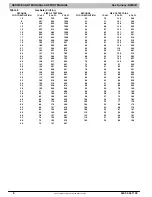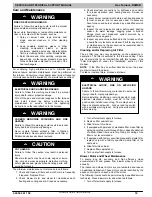
SERVICE AND TECHNICAL SUPPORT MANUAL
Gas Furnace: N9MSB
Specifications subject to change without notice.
14
440 04 4411 03
Figure 7
Heating and Cooling Application Wiring Diagram with Single
−
Stage Thermostat
115-V FIELD-
SUPPLIED
DISCONNECT
AUXILIARY
J-BOX
24-V
TERMINAL
BLOCK
THREE-WIRE
HEATING-ONLY
FIVE WIRE
NOTE 1
NOTE 2
FIELD-SUPPLIED
DISCONNECT
CONDENSING
UNIT
TWO
WIRE
FURNACE
C
O
N
T
R
O
L
R
G
COM
W
C
R
G
Y
GND
GND
FIELD 24-V WIRING
FIELD 115-, 208/230-, 460-V WIRING
FACTORY 24-V WIRING
FACTORY 115-V WIRING
208/230- OR
460-V
THREE
PHASE
208/230-V
SINGLE
PHASE
BLOWER DOOR SWITCH
WHT
BLK
WHT
BLK
NOTES:
Connect Y-terminal in furnace as shown for proper blower operation.
Some thermostats require a "C" terminal connection as shown.
If any of the original wire, as supplied, must be replaced, use
same type or equivalent wire.
W
Y
GND
THERMOSTAT
TERMINALS
1.
2.
3.
A11387
For an explanation of status codes, refer to service label
located on blower door or
, and the troubleshooting
guide which can be obtained from your distributor.
Retrieving Stored Fault Codes
NOTE
: Fault codes cannot be retrieved if a thermostat signal
(24-V on W, Y, G, etc.) is present, or if any delays such as
blower off-delays are active.
The stored status codes will NOT be erased from the control
memory when 115- or 24-V power is interrupted. See the
Service Label (See
) for more information. The most
recent fault code may be retrieved as follows:
1. Leave 115-V power connected to furnace.
2. Observe the status LED through the blower door (the
lower door on upflow applications) indicator. Refer to the
) to interpret the LED.
3. Remove the Main/Control door (the upper door on upflow
installations).
4. BRIEFLY disconnect and reconnect ONE of the main
limit wires.
5. The LED will flash the last stored fault code. Refer to the
) to interpret the LED.
6. A component test sequence will follow.
7. Reinstall the Main/Control door.
Component Self
−
Test
NOTE
: The furnace control component test allows all
components to run for a short time; except the gas valve and
humidifier terminal HUM 24 VAC are not energized. The EAC
terminal is energized when the blower is energized. The HUM
terminal is energized when the inducer is energized. This
feature helps diagnose a system problem in case of a
component failure. The component test feature will not operate
if any thermostat signal is present at the control and not until all
time delays are completed.
To begin Component Self
−
Test:
1. Remove blower access door.
2. Disconnect the thermostat R lead from furnace control.
3. Manually close blower door switch.
Caution must be taken when manually closing this switch for
service purposes.
ELECTRICAL SHOCK HAZARD
Failure to follow this warning could result in personal
injury, or death.
Blower access door switch opens 115
−
V power to
control. No component operation can occur unless
switch is closed. Caution must be taken when
manually closing this switch for service purposes.
!
WARNING
4. For approximately 2 sec, short (jumper) the C terminal on
control to the TEST/TWIN 3/16—in. (5 mm)
quick-connect terminal on control until the LED goes off.
Remove jumper from terminals. (See
NOTE
: If TEST/TWIN and C terminals are jumpered longer
than 2 sec, LED will flash code 10 and ignore component test
request.
Component test sequence is as follows:
a. LED will display previous status code 4 times.
b. Inducer motor starts and continues to run until Step f of
component test sequence.
c. After 7 seconds the hot surface igniter is energized for
15 sec., then off.
d. Blower motor operates on HEAT speed for 10 sec.
e. Blower motor operates on COOL speed for 10 sec.
f. Inducer motor stops.
5. Reconnect R lead to furnace control, remove tape from
blower door switch, and re-install blower door.
6. Verify furnace shut down by lowering thermostat setting
below room temperature.
7. Verify that furnace restarts by raising thermostat setting
above room temperature.







































